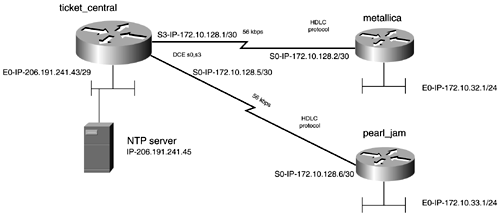Lab 35: Configuring NTP Servers, Clients, and Peer Associations ”Part I Practical Scenario As mentioned previously, NTP is a critical component to network management and for applications that may require an accurate time source. Cisco routers can be configured to synchronize to an external time source and, in turn , have other routers synchronize to them. Lab Exercise Independent Ticket, Inc. runs a concert ticket sales application that requires an accurate clock to ensure that ticket sales start and stop at the correct times. This particular application is run by a small group of bands that want to coordinate their own ticket sales instead of relying on existing ticket monopolies. The bands all have 56-kbps links to a small central site that provides common venue information, as well as a secure NTP server. The bands Metallica and Pearl Jam have recently signed up for NTP services. You are tasked to configure the new metallica and pearl_jam routers with the following conditions: -
The network will have a core router, ticket_central, with two 56-kbps HDLC links to the metallica and pearl_jam routers. -
An NTP server resides on the backbone Ethernet segment of the ticket_central router. The NTP server has an IP address of 206.191.241.45. Configure the ticket_central router to synchronize to this server. -
Configure the metallica and pearl_jam routers to form a peer association with the ticket_central router. -
All routers are located in the United States “Pacific time zone, which is an 8- hour offset from Greenwich Mean time or UTC. Ensure that this is the time zone for the network, and use the name of PAC for a description. -
(Optional) Prevent any NTP broadcast from being broadcast onto the Ethernet segments of the metallica and pearl_jam routers. Lab Objectives -
Configure the network as depicted in Figure 17-8. Use EIGRP as the routing protocol, with an autonomous System ID of 2001. Figure 17-8. NTP Peer Association Configuration  -
Configure the ticket_central router as an NTP master, and source its clock from 206.191.241.45, the NTP server. -
Configure the metallica and pearl_jam routers to form a peer association with the ticket_central router. -
The stratum level should be 5 at the remote sites. Equipment Needed -
Three Cisco routers. Two routers should be connected through V.35 back-to-back cables to the serial ports of the ticket_central router. -
Three LAN segments, provided through hubs or switches. -
An NTP server located on the Ethernet segment of the ticket_central router. Use the shareware site download.com to download an NTP server for the lab. The NTP server that we used is called TARDIS 2000 and is available at this site. Any NTP server or another router could also serve this function. Physical Layout and Prestaging -
Connect the hubs and serial cables to the routers, as shown in Figure 17-8. Use HDLC as the WAN protocol. -
Connect the three Ethernet hubs to the routers to form three LAN segments, as shown in Figure 17-8. -
Configure EIGRP across the network, use 2001 as the Autonomous System ID. -
Add and configure the NTP server on the Ethernet segment of the ticket_central router. Enable NTP broadcast, and set the stratum level to 3 on the software. The IP address of the server is 206.191.241.45. |
